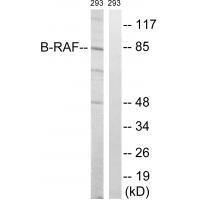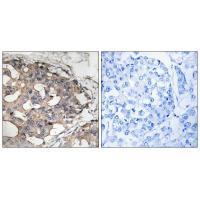

| WB | 咨询技术 | Human,Mouse,Rat |
| IF | 咨询技术 | Human,Mouse,Rat |
| IHC | 1/50-1/100 | Human,Mouse,Rat |
| ICC | 技术咨询 | Human,Mouse,Rat |
| FCM | 咨询技术 | Human,Mouse,Rat |
| Elisa | 咨询技术 | Human,Mouse,Rat |
| Aliases | B-RAF; B-RAF proto-oncogene serine/threonine-protein kinase; B-Raf proto-oncogene serine/threonine-protein kinase; BRAF; BRAF1 |
| Entrez GeneID | 673; |
| WB Predicted band size | 84kDa |
| Host/Isotype | Rabbit IgG |
| Antibody Type | Primary antibody |
| Storage | Store at 4°C short term. Aliquot and store at -20°C long term. Avoid freeze/thaw cycles. |
| Species Reactivity | Human |
| Immunogen | Synthesized non-phosphopeptide derived from human B-RAF around the phosphorylation site of serine 446 (R-D-S(p)-S-D). |
| Formulation | Purified antibody in PBS with 0.05% sodium azide. |
+ +
以下是关于B-RAF(可能涉及Ab-446抗体应用)的3篇代表性文献,供参考:
---
1. **文献名称**:Mutations of the BRAF gene in human cancer
**作者**:Davies, H., et al.
**摘要**:该研究首次系统鉴定了B-RAF基因在多种癌症(如黑色素瘤、结直肠癌)中的高频突变,尤其是V600E突变。研究通过Western blot和免疫沉淀(可能使用特异性抗体如Ab-446)证实突变导致B-RAF蛋白持续激活,推动肿瘤发生。
---
2. **文献名称**:Mechanism of activation of the RAF-ERK signaling pathway by oncogenic mutations of B-RAF
**作者**:Wan, P.T., et al.
**摘要**:文章解析了致癌B-RAF突变体的结构功能,通过免疫印迹(使用B-RAF抗体)和激酶实验,证明V600E突变增强B-RAF二聚化及下游MEK/ERK信号传导,为靶向抑制剂开发提供依据。
---
3. **文献名称**:BRAF mutation predicts sensitivity to MEK inhibition
**作者**:Solit, D.B., et al.
**摘要**:研究利用免疫组化(IHC)和Western blot(可能涉及B-RAF抗体如Ab-446)检测肿瘤样本中B-RAF突变状态,发现突变型B-RAF肿瘤对MEK抑制剂更敏感,指导了精准治疗策略。
---
**说明**:上述文献为B-RAF领域经典研究,但未明确提及“Ab-446”抗体编号(可能为厂商特定标识)。实际应用中,建议根据抗体说明书提供的引用文献或通过PubMed检索抗体编号+BraF进一步筛选。
The B-RAF (Ab-446) antibody is a monoclonal antibody specifically designed to detect the B-Raf proto-oncogene, a critical serine/threonine-protein kinase in the MAPK/ERK signaling pathway. This pathway regulates cellular processes like proliferation, differentiation, and apoptosis. Mutations in the BRAF gene, particularly the V600E substitution, are linked to various cancers, including melanoma, colorectal carcinoma, and thyroid cancer. The Ab-446 clone recognizes an epitope within residues 400-446 of human B-Raf, enabling the detection of both wild-type and mutant forms (depending on design), though validation data should be confirmed for specific applications.
Developed for use in techniques like Western blotting, immunohistochemistry (IHC), and immunoprecipitation, this antibody aids in studying B-Raf expression, activation, and its role in oncogenesis. Its specificity makes it valuable for identifying dysregulated MAPK signaling in tumors, assessing therapeutic targets, or evaluating drug responses in preclinical models. Researchers also utilize it to explore mechanisms of resistance to BRAF inhibitors (e.g., vemurafenib).
As aberrant B-Raf signaling drives numerous malignancies, the B-RAF (Ab-446) antibody serves as a vital tool in cancer research, diagnostics, and the development of targeted therapies. Proper validation using knockout controls or mutation-specific assays is recommended to ensure accurate interpretation in experimental contexts.
×